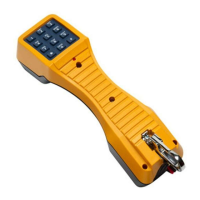
Do you have a question about the Fluke TS 19 and is the answer not in the manual?
| Type | Butt Set |
|---|---|
| Continuity Indication | Yes |
| Talk Battery | Yes |
| Current Limiting | Yes |
| Overload Protection | Yes |
| Mute Function | Yes |
| Polarity Indication | Yes |
| Tone Dialing | Yes |
| Pulse Dialing | Yes |
| Last Number Redial | Yes |
| High Impedance Monitor | Yes |
| Battery Test | Yes |
| Operating Temperature | 0 °C to 50 °C |
Warning regarding risk of personal injury, refer to manual for details.
Caution regarding risk of damage or destruction to equipment or software, refer to manual.
Warning regarding risk of electric shock.
Explains the Earth ground symbol and its meaning.
Indicates conformity to relevant European Union directives.
Lists relevant Canadian and US safety certifications and standards.
Instruction to dispose of circuit boards in accordance with local regulations.
Warns against connecting to 117V AC commercial power, voiding warranties.
States the TS19 is not for outside plant use or adverse weather.
Advises not to use a damaged test set and to inspect it before use.
Warns that improper use may impair product protection.
Details the case design, handgrip contour, recessed keypad, belt clip, and cord configurations.
Explains the LNR button function for redialing the last dialed number.
Explains the three-position switch for monitoring, ringing, and talking modes.
Describes the switch for selecting DTMF tones or dial pulses.
Explains how keypad keys send DTMF tones or dial pulses based on switch settings.
Describes the red LED indicating line polarity when connected to Tip and Ring.
Details the standard banana jack cord and the piercing pin cord with alligator clips.
Describes ground start cords with banana jacks and angled bed-of-nails cords.
Warning to handle alligator clips by insulated boots when connecting to network wires.
Instructions for monitoring telephone lines using the HI Z switch position.
Steps to check line polarity using the HI Z/RING/TALK switch and Polarity LED.
Procedures for dialing numbers using the keypad and PULSE/TONE switch.
Instructions on how to use the Last Number Redial feature.
How to use the electronic ringer and disable it.
Explains how to use clicks to locate shorts, opens, and verify continuity.
Warning about potentially loud clicks when testing near battery sources.
Warning to disconnect clips before maintenance and read instructions.
Caution against using chlorinated solvents that can damage the unit.
Instructions for replacing the belt clip assembly.
Instructions for replacing the line cord.
Details electrical parameters like loop limit, resistance, impedance, and dial output.
Lists the physical dimensions and weight of the test telephone.
Outlines operating and storage temperature, drop rating, altitude, and humidity.
Lists the regulatory standards the product complies with.
Details product certifications and compliance with EU, CSA, and UL standards.
